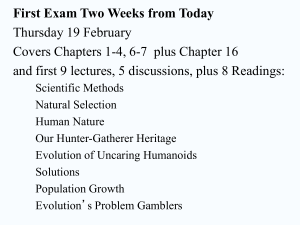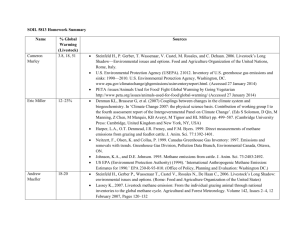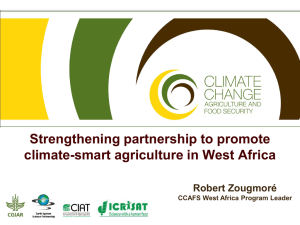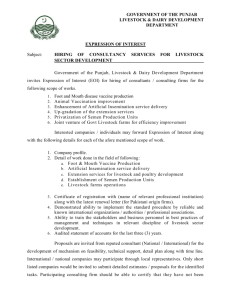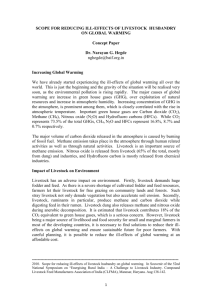Radical Natural Climate Solutions
advertisement
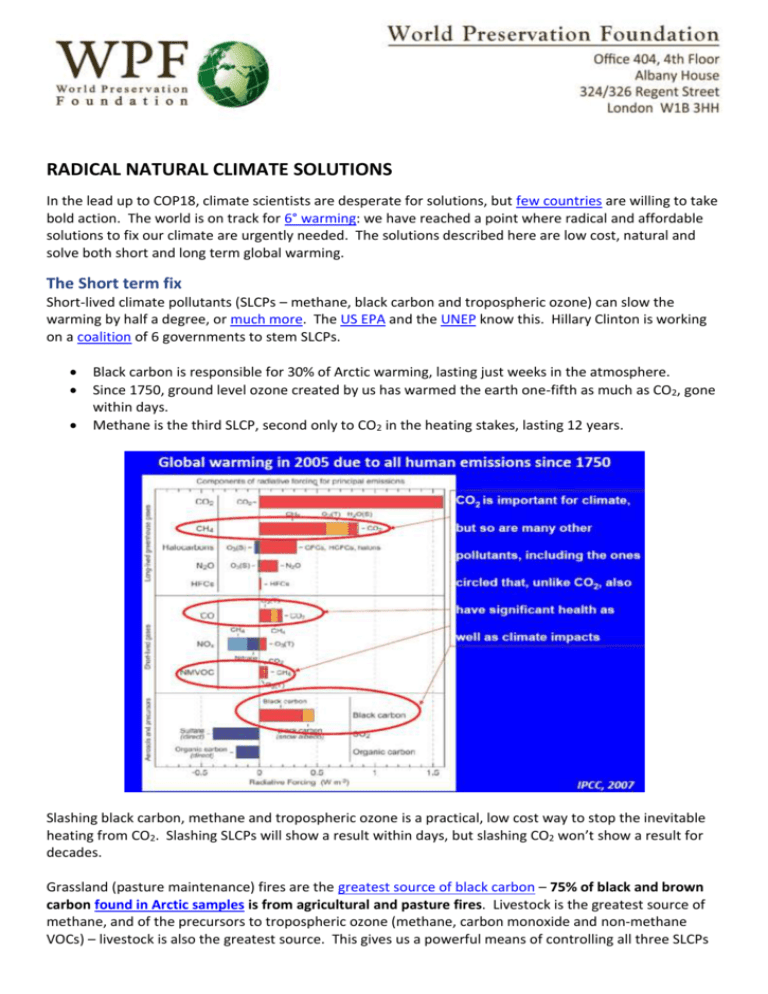
RADICAL NATURAL CLIMATE SOLUTIONS In the lead up to COP18, climate scientists are desperate for solutions, but few countries are willing to take bold action. The world is on track for 6° warming: we have reached a point where radical and affordable solutions to fix our climate are urgently needed. The solutions described here are low cost, natural and solve both short and long term global warming. The Short term fix Short-lived climate pollutants (SLCPs – methane, black carbon and tropospheric ozone) can slow the warming by half a degree, or much more. The US EPA and the UNEP know this. Hillary Clinton is working on a coalition of 6 governments to stem SLCPs. Black carbon is responsible for 30% of Arctic warming, lasting just weeks in the atmosphere. Since 1750, ground level ozone created by us has warmed the earth one-fifth as much as CO2, gone within days. Methane is the third SLCP, second only to CO2 in the heating stakes, lasting 12 years. Slashing black carbon, methane and tropospheric ozone is a practical, low cost way to stop the inevitable heating from CO2. Slashing SLCPs will show a result within days, but slashing CO2 won’t show a result for decades. Grassland (pasture maintenance) fires are the greatest source of black carbon – 75% of black and brown carbon found in Arctic samples is from agricultural and pasture fires. Livestock is the greatest source of methane, and of the precursors to tropospheric ozone (methane, carbon monoxide and non-methane VOCs) – livestock is also the greatest source. This gives us a powerful means of controlling all three SLCPs and a radical, low cost, natural solution to near term warming. Incremental and technical solutions to livestock emissions have been dismissed as inadequate for transformational change. The Long term fix Geo-engineering efforts to cool the planet have been blocked because they cost too much or have dubious side-effects. Even proponents talk about the least-worst options. A large-scale, low-cost, least side-effect solution was proposed by the Netherlands Environmental Assessment Agency in 2009 as one radical option: stop eating meat, and return the world’s grazing pastures to forests, savannah and native grasslands. Seriously. They found that this solution would cost just 1/5th of any other mitigation option. This has the potential to draw down at least 20 years of CO2 emissions, and we don’t even have to plant trees – we need only to stop burning. A prime example of this was published in Nature in 2011 – if the burning stopped, 51% of the African continent would revert to woodland and forest. Africa is the world’s fire capital, where herders burn off dry grass every year. NASA MODIS satellite image of fires from 19-29 July 2012 showing that Siberia is still burning. Note the African “fire continent” savannah fires and the South American agricultural fires. (NASA, 2012) Eating has more effect on our planet than anything else we do. Grazing land covers 30% of the land mass (70% of all agricultural land) and half the cropland is for feed. Much of this land was forest. Australia recognises this in its Carbon Farming Initiative. The top half of Australia is open tropical woodland, and is burnt each year to remove dead grass for grazing. Just by burning early in the dry season was found to reduce emissions by half. Market distortions and lack of public debate are the biggest obstacles External environmental costs are not paid by livestock industries. Billions of dollars in government subsidies support meat and dairy industries, distorting the market, making the excellent plant-based proteins less competitive. The media must pick up this debate – this is the only low cost, large scale, minimal impact solution to arrest the inevitable heating, plus draw down the legacy CO 2. Climate chaos will force us to take these ideas very seriously. Common objections Pasture land cannot be used to grow crops. Yes, but in this age of climate (and biodiversity) crisis, the highest and best use of 30% of the earth’s surface is to grow more trees and perennial native grasses to soak up legacy CO2. We need all the food we can produce and more. No. Livestock’s Long Shadow showed we would have a 50% surplus of food if we stopped eating meat. Animals eating grass, producing methane that breaks down to CO2 is a natural cycle. No. Methane is CO2 on steroids, and we artificially breed 64 billion livestock each year – hardly natural! Savannah burns naturally anyway. Yes, but far less frequently. Most pastures are tropical savannah, where lightning strike fires are rare. The major driver by far is “tossing the match” (actually, drip-torch is the method of choice). Frequent burning is very effective – it stops forests re-growing. Traditional indigenous fires were fine-scale mosaics set throughout the dry season, and were far less widespread. Cell grazing builds soil carbon. Yes, but most grazing livestock are on tropical pastures, where low stocking rates and fewer water points make cell grazing prohibitive – aside from the livestock emissions. Grass fed beef is better for the environment. No. Cattle produce 3-5 times more methane eating grass than they do eating grain, and almost all cattle are “finished” on grain in any case – to make the meat more marketable. Traditional herders rely on livestock. Some still do, but even the Masai in eastern Africa are turning to cropping because their herds are dying in the extreme drought. Traditions can change very quickly. Gerard Wedderburn-Bisshop
